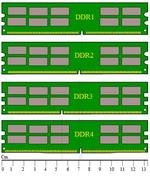DDR5 vs LPDDR5: Key Differences Explained
Advertisement
DDR5 (Double Data Rate 5) and LPDDR5 (Low Power Double Data Rate 5) are two different types of memory with some similarities.
Both offer higher data transfer rates than their predecessors (DDR4 and LPDDR4, respectively), achieved through improved signaling and technological advancements.
However, they differ significantly in their target applications, power efficiency, and form factors.
DDR5 Memory
DDR5 is a type of synchronous dynamic random-access memory (SDRAM), the fifth generation of the DDR standard. It improves upon DDR4 with enhanced data transfer rates, capacity, and efficiency.
DDR5 memory modules consist of multiple memory chips mounted on a printed circuit board (PCB). Each chip contains an array of memory cells organized in rows and columns, along with addressing logic, I/O circuitry, and other components for data transfer.
Here are some key features of DDR5 memory:
-
Higher Data Transfer Rates: DDR5 uses improved signaling techniques for faster communication between the memory and the rest of the system.
-
Increased Capacity: DDR5 supports higher memory capacities per module, which is great for applications requiring large amounts of RAM, like high-performance computing and gaming.
-
On-Die ECC (Error-Correcting Code): DDR5 introduces on-die ECC, enhancing the memory’s ability to detect and correct errors, leading to improved data reliability and system stability.
-
Bank Group Architecture: This architecture allows for more efficient data access by enabling parallelism in memory operations, resulting in better performance.
-
Reduced Voltage: DDR5 operates at a lower voltage than DDR4, improving power efficiency by lowering power consumption and heat generation.
-
Improved Prefetching: DDR5 incorporates improvements in prefetching mechanisms, enhancing the efficiency of data retrieval and contributing to better overall system performance.
LPDDR5 Memory
LPDDR5 is a low-power synchronous dynamic random-access memory primarily designed for mobile devices like smartphones, tablets, and ultrabooks.
Like DDR5, LPDDR5 memory modules consist of multiple memory chips on a PCB. However, the construction is optimized for power efficiency and compact form factors to suit the needs of mobile devices.
Key features of LPDDR5 memory include:
-
Low Power Consumption: LPDDR5 is specifically designed for low power consumption, making it ideal for battery-powered devices. It achieves this through various power-saving features, like lower operating voltage and advanced power management.
-
High Data Transfer Rates: Despite being low-power, LPDDR5 still offers high data transfer rates, which is crucial for supporting modern mobile applications, including high-resolution video playback and advanced graphics.
-
Improved Bandwidth: LPDDR5 improves memory bandwidth, enabling faster data access and retrieval, which is beneficial for multitasking and running memory-intensive applications on mobile devices.
-
Deep Sleep Mode: LPDDR5 includes a deep sleep mode that allows the memory to enter an even lower power state when not actively in use, extending battery life in mobile devices.
-
Adaptive Voltage Scaling: This feature allows the memory to dynamically adjust its voltage based on the workload, optimizing power consumption based on the processing requirements at any given time.
-
Compact Form Factor: LPDDR5 is designed with a compact form factor, making it suitable for integration into slim and lightweight mobile devices where space is a critical consideration.
Difference between DDR5 and LPDDR5
The following table highlights the key differences between DDR5 and LPDDR5 memory:
| Parameters | DDR5 | LPDDR5 |
|---|---|---|
| Power consumption | Generally higher | Lower (optimized for mobile) |
| Voltage | Higher (typically 1.1 V) | Lower (typically 1.05 V) |
| Data transfer rate | Higher | Lower |
| Density and capacity | Higher density, higher capacity | Slightly lower density, lower capacity (optimized for mobile) |
| Form factor | Larger modules, less compact | Smaller modules, compact design |
| Bandwidth | Higher bandwidth | Slightly lower bandwidth |
| Latency | Generally lower | Slightly higher |
| Cost | Typically lower | May be higher due to mobile optimization and power efficiency features |
| Use cases | High performance computing, gaming | Mobile devices, ultrabooks, tablets |
In summary, both DDR5 and LPDDR5 improve performance, efficiency, and capacity over their predecessors. DDR5 is geared towards high-performance computing, while LPDDR5 is tailored for power-efficient use in mobile devices. Their specific features and characteristics cater to the different requirements of desktop systems and mobile platforms, respectively.
Advertisement
 RF
RF

